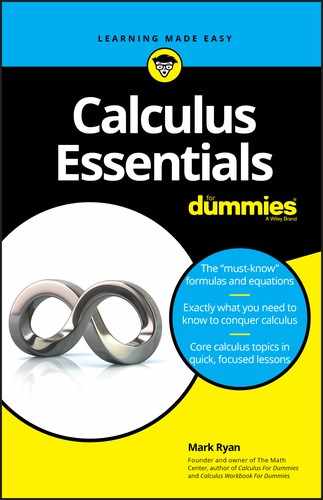Index
A
C
- calculus, 5–8. See also differentiation; integration; limits
- chain rule, 54–58
- change, calculus as mathematics of, 6–8, 14, 33
- closed interval, absolute extrema for, 69–71
- coefficients, equating, 155–156
- composite functions, differentiating, 54–58
- concavity of function, 63, 66–69
- concavity points, 73–75, 77
- conjugate multiplication, 27–28
- constant multiple rule, 50–51
- constant rule, 49
- continuous functions, 16, 17, 21–22, 26
- convergence, improper integral, 172
- cosecants, integration of, 147
- cosines, integration of, 141–144
- cotangents, integration of, 147
- critical points, 62–65
- curve. See also parabola
D
- decreasing derivative, 62–63
- definite integral, 116–117
- derivative. See differentiation
- difference quotient, 40–46
- difference rule, 51
- differentiation
- absolute extrema, 62, 69–72
- acceleration, 84, 86, 89–90
- antidifferentiation, 119–121, 128–135
- chain rule, 54–58
- of composite functions, 54–58
- concavity points, 73–75, 77
- constant multiple rule, 50–51
- constant rule, 49
- critical points, 62–65
- of a curve, 39–40
- decreasing derivative, 62–63
- described, 8–9, 23, 34–39, 46
- difference quotient, 40–46
- difference rule, 51
- of exponential functions, 52–53
- First Derivative Test, 65–66
- graph of, 75–78
- implicit, 59–60
- increasing derivative, 62–63
- inflection points, 73–75, 77–78
- of a line, 36
- linear approximation, 97–100
- of logarithmic functions, 52–53
- not existing, 47–48
- optimization problems, 81–83
- power rule, 49–50
- product rule, 53–54, 178
- quotient rule, 54, 178
- of radical functions, 50
- as rate, 36–38
- related rates, 91–96
- Second Derivative Test, 66–69
- as slope, 34–35
- sum rule, 51
- of trigonometric functions, 52
- velocity, 84–88
- disk method, 163–164
- displacement, 87–88
- distance traveled, 88–89
- divergence of improper integral, 172
- division by zero, 26, 175. See also undefined fraction
E
F
G
H
I
- icons used in this book, 3
- implicit differentiation, 59–60
- improper integrals, 171–174
- increasing derivative, 62–63
- indefinite integral, 120–121
- infinity
- inflection points, 73–75, 77
- instantaneous rate, 46–47
- instantaneous speed, 19–21
- integration
- antidifferentiation, 119–121, 128–135
- approximations of, 105–116
- arc length, 168–170
- area between two curves, 160–162
- area under a curve, 12–13, 103–105, 121–124
- average value of a function, 159–160
- definite integral, 116–117
- described, 9–10, 101–103
- equating coefficients, 155–156
- Fundamental Theorem, 124–128
- improper integrals, 171–174
- indefinite integral, 120–121
- Mean Value Theorem, 158–159
- partial fractions method, 152–155
- by parts, 137–140
- rules for, 128
- of trigonometric functions, 141–151
- volumes of solids, 162–168
K
- Kasube, Herbert E. (mathematician), 139
L
- left sums, 105–108
- length of curves, 13–14, 168–170
- length of hypotenuse, 13–14
- LIATE acronym, 139–140
- limits
- conjugate multiplication for, 27–28
- of continuous functions, 16, 17, 21–22, 26
- described, 11–14
- factoring for, 27
- of functions with holes, 22–23
- with horizontal asymptotes, 18–19, 30–31
- at infinity, 18, 29–31, 173–174
- instantaneous speed using, 19–21
- list of, common, 25–26
- one-sided, 17
- simplification for, 28–29
- substitution for, 16, 27
- two-sided, 15–17
- with vertical asymptotes, 18
- line
- linear approximation, 97–100
- local extrema, 62–69, 75, 86–87
- local maximums and minimums, 62
- logarithmic functions, differentiating, 52–53
M
N
- negative area, 105
O
P
Q
R
S
- secant line, slope of, 40–42
- secants, integration of, 144–146, 151
- Second Derivative Test, 66–69
- sigma (summation) notation, 112–116
- simplification, 28–29
- sines, integration of, 141–144, 150–151
- slope
- SohCahToa mnemonic, 175
- solids, volumes of, 162–168
- speed, 19–21, 86, 88–89
- stationary points, 62
- steepness. See slope
- substitution
- sum rule, 51
- summation (sigma) notation, 112–116
T
U
- undefined fraction. See also division by zero
V
W
- washer method, 165–166
X
Y
- y-coordinate, point, 77
..................Content has been hidden....................
You can't read the all page of ebook, please click here login for view all page.
